Print this review
S60 Summit, Madrid 2007
S60 Summit 2007. Expo>>>
Events like S60 Summit are oriented more to the partners rather than press, and all the more exiting it is to attend them. The opening speech by Matti Vanska was very optimistic and there are all the prerequisites for that, actually.



The last year’s Summit was attended by about 500 men, and this year’s event saw a 10 percent growth. The primary task is demonstration of what the world of the S60 looks like today. Among the visitors are not only developers, carriers’ and vendors’ representatives, but also press, analysts, those who guide the market to a greater or lesser extent. In the exhibition area you could witness Samsung’s new smartphone – the SGH-I400, the first model to retain the S60’s latest version with the ability to recharge via USB and have a claim for the mass market.

The crucial success factors for the S60 are production volume, offering new experience, ability to make up new devices and editions in short term. In the sense of innovations, it needs to be noted that mobile solutions are getting to be the centerpiece of systems involving personal, mobile Internet, which automatically implies convergence between operators and Internet-services.

In the first quarter 2007 around 20 million units of S60-devices were shipped, which stands for a bit more than a 50 percent share of the whole smartphone market. Accumulated sales of S60-based devices have gone over 100 million units. After these words the hall started acclaiming, which is no surprise – the S60 is beyond competition as of today, while Windows Mobile still has a long way to go before it can become a threat to the S60. With the growth of smartphone and communicator market, the share of the S60 will be going down, which is a natural process, but in terms of units shipped the S60 will be topping the market for years to come, this is the fact one would barely deny.

Now let us shed more light on some presentations made at S60 Summit. For the most part, these were personal thoughts of the speakers, that is why the text below might feature direct speech and so on.
S60 Extending the Internet
Ilari Nurmi
Director, Product Management, Software Platform, Nokia
Download presentation in a format pdf (4.3 Mb)>>>
The S60 has a very clear strategy regarding Internet and development of various online-based services, as this is one of the most vital device constituents. The company’s primary mission is to make the Internet go truly mobile. We could give an example of Nokia Web Browser, which is the first browser to feature true desktop-like Web browsing experience, being installed already in 10 millions of sold handsets (first and second versions). This browser has been awarded by many competent resources.

But not only does the Internet provide for viewing web-pages, but also it allows various services. The S60 is developing in this way as well – you can instantly think of integration of Flickr, Yahoo Go, Google Maps, Locr and others in the S60-powered solutions. To ensure maximum capabilities for the developers of such services, the S60 offers a wide selection of run-time technologies, with C placed at the frontier. Open C can be easily adapted to applications (ported), familiar to most programmers, and they say over at the S60, they don’t set off to reinvent the wheel and offer a well-known environment. The proof of Open C advantages is given in the form of several examples, specifically, port of SQLite took 3 hours (84000 lines of code), HyperEstraier Search Engine 2 months without any manuals used.

The development of S60 SDK goes in the direction of Carbide (C++ or Carbide v.2.0). In future they are planning on adding more graphical tools to the environment, improve emulator experience, leverage Eclipse ecosystem.

S60 is the first platform to have Widgets integrated, this is web 2.0 technology, allowing to attach users to using mobile Internet, and giving the developers new capabilities of creating new services and truly mobile applications. The main advantages of widgets are as follows:
Familiar – known from desktop PCs.
Rapid – fast time-to-market, simplicity.
Simple – easy to use, clear concept.
WeatherBug was given as a widget example – indeed, such applications are popular, remember, for instance, Handy Weather. In this widget you can not only check out the weather forecast, but also upload a satellite map – with no Internet connection at hand, such ability would be totally impossible.

Reuters News Widget – gathers main news items from Reuters, this widget shows how easy the development process is, as it was written in just five days. Unsophisticated, yet very useful widget it is.

Widgets add more value to cell phones than PCs – the philosophy is what differs. These applications are what really build personalized Internet, mobile Internet. That’s why the motto “Your Internet. Wherever You are” makes much sense.
Using Convergence Services on S60 to Increase Revenues in mature markets
Jose Antonio Moujadami
Telefonica
Head of Application and Open OS Devices
Download presentation in a format pdf (3.7 Mb)>>>
The evolution of technology shows that SMS is no longer the unique relevant data bearer (in person-to-person communications), while the content is working its way up (from 31 in 2005 to 33 percent in 2006). Mobile Internet is growing even faster – from 6 to 9 percent over the same time span. We have stabled a unique data tariff that offers unlimited Internet access for 1 Euro a day and it is vastly popular. The only limitation for us is the price for such devices – today feature-rich smartphones cost about 600 Euro, in future price decline will reignite the market.

For us, as an operator, openness is what matters the most, willingness of the vendor to create services with us, adapt already existing to our networks. We are into innovations and new services, development of OpenSource. Of course the industry orients to the content generated by UGC users, which is an import part of services development.

The primary task is getting tariffs perception easier. Data tariffs should not be hard to come to grips with, they should be unsophisticated, even though they are backed up by technologies (for example our tariff 1 Euro for 1 day of mobile Internet).

Traditional barriers have been removed and the competitive environment is complex, any developer has access to device’s operating system, older players can’t make use of defensive strategies against the young companies, it is the consumer who picks the device in the end. Operators need to provide superior value to succeed. To do that they need to use customer effectively, delight consumers with the best care and services. Only giving the best experience through technology they can keep their current positions on the market or strengthen them. The factor of success is not only software, but also UGC, shared and superior knowledge (i.e. Wikipedia).

How S60 helps operators to succeed?
S60 Browser today can work everywhere – by this we mean not only handsets, but also TV-sets, trop computers, gaming consoles, and so on. This grants wholly different opportunities to the operator. The browser’s advantages are its openness, reliability and a PC forefather.
Another constituent is Open C environment, which brings open source methods and current applications to mobile, increases competitiveness on the application market, blurs the edges between desktop OC and mobile device. The community now can drive development into the direction that they need, not the vendor; this is an important part of the development.


Unique user experience allows operators to:
- Deeply segment consumer groups
- Create unique products – box, menu, pre-installed content-based applications
In a nutshell, S60 is a tool that could help operators to capture innovation, reduce the time-to-market and the fragmentation, provides sources for a deep differentiation. This is becoming a vital constituent of any operator’s growth.
Role of Software Platforms in bringing innovative services to market – operator perspectives
Karman Kordi
T-Mobile
Download presentation in a format pdf (244 Kb)>>>
For an operator, right choice of the platform means its predictable performance, consistent quality, better maintenance, cost reduction, scalability and other benefits. This implies that picking the platform is a key step to address challenges facing the operator.

Standardization. Opportunity to unify solutions across multiple vendors.
Innovation. Ability to try out services without having bespoke terminals built
The market features multiple hybrid platforms and solutions, at that these platforms differ in terms of both hardware and software. For operators this is a true Gordian Knot, as money funds are spent on support for various platforms, real-life tests. And this is ô really expensive treat



The today’s S60 also has weak spots, since operators can influence minimal parts of the core requirements for terminals and functionality. At the same time they can ensure manufacturers conform to agreed operator. On the upside, S60-based devices run on various hardware solutions, yet share the software platform, which makes development less expensive. Modularity of the platform increases with time, which brings more opportunities for operators.


Future Opportunites in the connected world
Shaun Collins
CCS Insight, Managing Director
Download presentation in a format pdf (796 Kb)>>>
The world we live in has changed much – we are no longer bound to a certain place, we have entered the ear of untethered communications, where the paradigm is shifting from voice to visual interaction with devices on the move. Today we can stay connected wherever we are, we don’t have to call at the nearest post office to send a litter, we can even pay bills having a breakfast in, say, a cafe. The new paradigm states that you can actually see the services, they are near you, they are everywhere.
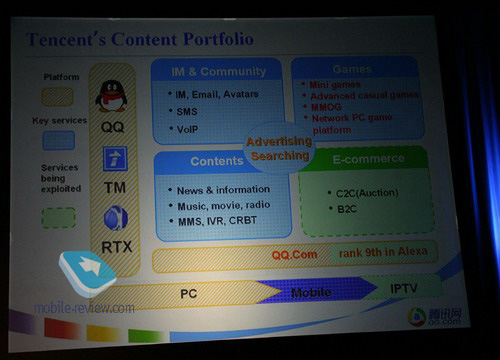
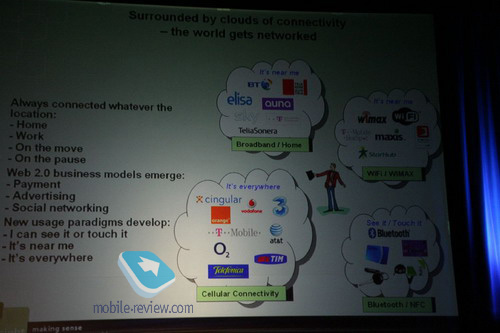
New companies emerged on the market, such as Yahoo, Google, Microsoft, they stormed into the market of cable/mobile/TV operators. By creating tension on the market, they unintentionally stir up other players.
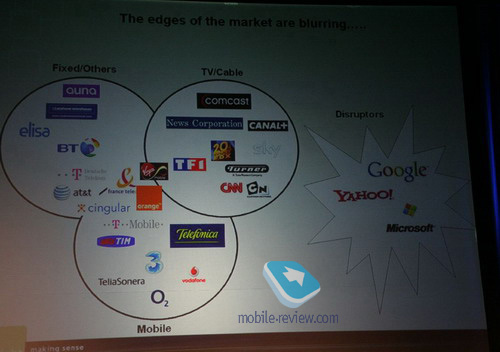
When it comes to services, we come across the fact that the operators are not willing to make the user’s life easier. There is no simplicity in these relations; flat rate offered in the UK for mobile Internet usage is a fantastic move. You always know how much you spend and don’t have to wonder upon getting enormous bill. Though, technology matures more slowly than expected, with fragmentation leading to slow adoption. One of the reasons is that the key stakeholders (e.g. connectivity suppliers) resist partnerships and new business models. This is amplified by conservatism of consumers about new technologies and new form factors.
The world has changed. It took Reuters only 5 days to come up with a mobile widget for accessing its content; there are many companies out there that would need this much time to decide on doing something similar. The business structure itself has changed, The Web giants are getting serious about mobility, they bypass the mobile operators with new technology, offerings new services and faster time-to-market.
Which areas are emerging today?
Music. Digital music revoltion, streamed content, changing business models.
Location. Navigation services, adding context to location-based applications, new revenues
Imaging. Many devices come included with cameras, sharing experience, blogging and so on are now truly possible.
Games. Network gaming, increasing capable devices (memory, display, audio)
Other applications – Search, TV, Connected home, Enterprise
Wrapping it all up, we could say that an increasing number of network operators will focus on a decreasing number of software platforms, people will purchase experience rather than technologies. Affordable flat rate data tariffs will be key catalysts for applications and services uptake. Platform S60 might become a part of this future, a successful part that will reduce market fragmentation, making it more transparent.
S60 reaching out for new segments and markets
Mikko Rontynen
Head of S60 platform marketing
S60 enables highly segmented devices, which can be classic smartphones with the functionality consumers have come to expect from convergent devices. These devices may have various form-factors. At the same time S60 allows developing music-minded, imaging-centric, sporty solutions, etc. This creates extra niches for products, sets them apart from each other, and makes them unique. The flexibility of S60 provides for maintaining user experience (standard interface and suite of features) and ability to add specific functions.
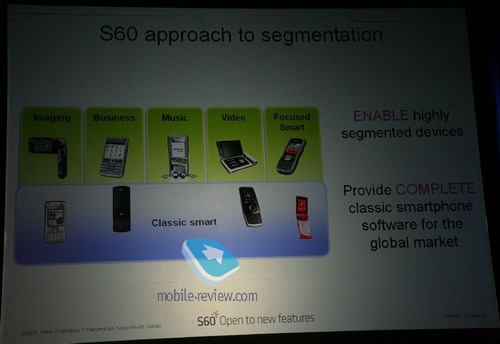
Today S60 offers a complete suite of smartphone applications – multimedia, PIM, messaging, browsing, telephony and so on.
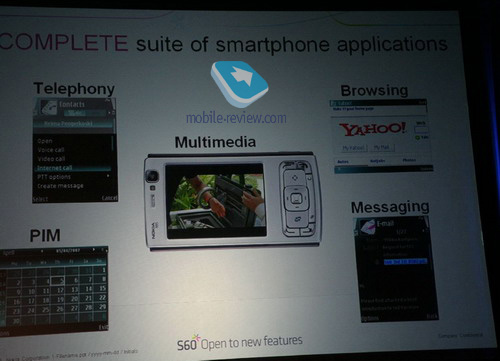
The data on how and for what people use their devices also looks interesting. A thing of note – voice calling are obviously inferior to messaging in this sense.
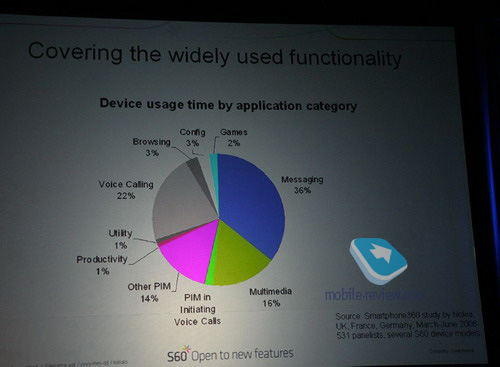
In Feature Pack 2 we made an attempt to simplify usage of S60 devices as much as possible, make them easier for uptake. So, composing a message, you don’t have to think over which type (SMS or MMS) is right for this particular situation, it is automatically tweaked depending on the content you put into it. Then, one browser for both Web and mobile content. Label for middle soft-key, makes for more convenience. Easier to find the multi-tasking capability. All these interface-related enhancements should make the devices easier to use. You can learn more about all novelties of the Feature Pack 2 in our dedicated article.
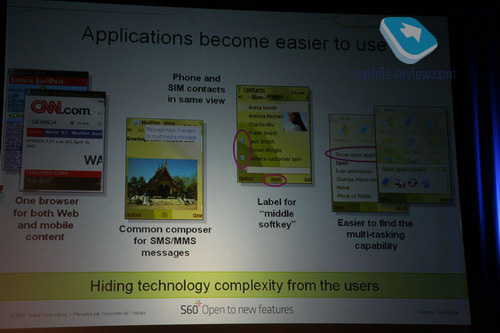
The FP2 comes pre-installed with 49 languages, in future more are going to be added. Apart from that, some applications will get enhanced with special features like lunar calendar for the Asian market; Islamic regions will get devices with specific tweaks as well.
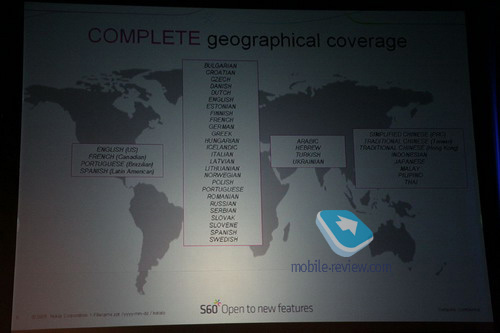
The hardware and software abilities of S60 enable creating devices housed in different form factors – with or without keyboard, various suites of accessories and so on. This system proves to be flexible on all levels.
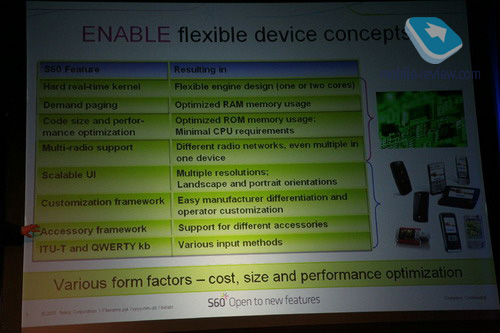
Differentiation with software brings about great capabilities, allowing to leave out unnecessary components, modify their design, code, that is also accessible.
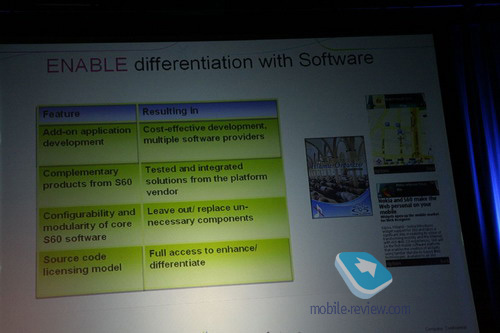
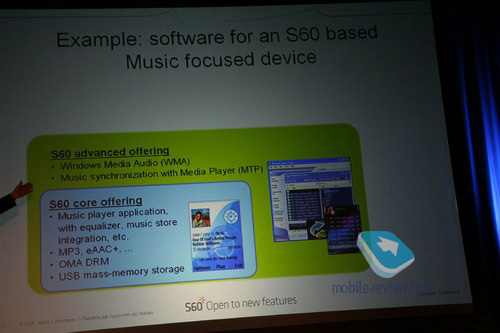
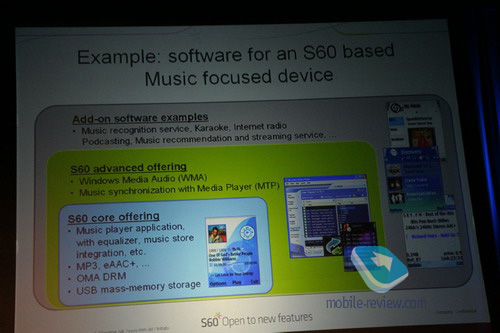
Eldar Murtazin (eldar@mobile-review.com)
Translated by Oleg Kononosov (oleg.kononosov@mobile-review.com)
Published — 26 April 2007
Have something to add?! Write us... eldar@mobile-review.com
|


































